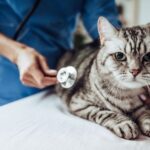Obesity in pets, especially for dogs and cats is a growing health risk. It is something that is often not recognized by people. Some people find it adorable, but it is a serious health risk.
Pet obesity
It’s possible that you won’t notice your pet gaining weight. This is because it usually happens slowly. People who own pets know that the ideal weight for their pet is subjective. It’s hard to tell when your pet is slightly overweight or below. Most people can recognize when a pet has become severely overweight. A dog or cat with large fat deposits on the chest, spine and base of their tail, and a distended belly, is considered obese. The animal appears round and pear-shaped from the top.
Diabetes in pets
As in humans, obesity can cause secondary orthopedic and medical problems in pets. Diabetes can also be a secondary problem to obesity. Insulin is released by the pancreas when blood sugar levels rise (eating a meal). The pancreas becomes worn out when an obese animal is constantly over-stimulated. It cannot produce the insulin it needs to maintain normal blood sugar levels. Although diabetes can be controlled and treated, it can cause blindness in some dogs and severe muscle weakness in others cats.
Animals with pancreatitis
Another condition I often see in obese dogs and cats is pancreatitis. The pancreas produces insulin and other enzymes that aid in digestion. The pancreas secretes enzymes in this condition, which can cause the pancreas’ to actually start digesting itself. Pancreatitis can cause vomiting, diarrhea, and severe abdominal pain in cats and dogs. This condition can lead to death if it is not treated.
Pets with joint problems
Obesity can also lead to arthritis and degenerative joint disease. The simple truth is that the more weight joints and tendons support, the more they start to fail, causing severe and chronic pain.
Pets’ weight maintenance
How can you prevent obesity in your pet? Be aware that obesity is a problem in companion animals. As with humans, some animals have a faster metabolism than others and will burn calories slower. Some pets can maintain a healthy weight with little help from their owners, while others require a strict gatekeeper at the food bowl.
Maintain a good working relationship with your vet. Your veterinarian can help you decide the ideal weight for your pet, offer diet options, and alert you when your pet is going in the wrong direction. Feeding: Cats and dogs should be given a balanced amount of food each day. This will not only prevent your pet’s overeating but it also allows you to closely monitor his food intake and detect changes in appetite, which can be a sign of serious illness. You can ask your veterinarian to help you decide how much food your pet should consume each day.
This is especially important for multiple cats. Although it takes time, you can begin to understand the habits and dietary requirements of your cats. You can give your active cats extra food to help them eat enough calories. This will prevent them from developing severe liver disease. You can also separate your cats during feeding so that you can personalize their meals.
Third, don’t give your pets food from strangers. Give treats only when you are sure they will enjoy them. While it’s fine to give your pet some variety in their food, or to reward good behavior, don’t go overboard. Food does not always equal love, as I emphasize often. Play time, walks, and time alone with your pet are all ways to say “I love” as well as giving treats.
Exercise and diet are important
Exercise and diet are the best options for pets who are already overweight. To avoid injury, slow and steady weight loss is best for severely overweight pets. Slow and steady weight loss is the best way to go. Before you put your pet on a weight loss program, make sure to consult your vet. It is equally important to lose weight safely for our pets, as it is not to become obese.




